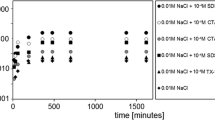Abstract
Hydroxyethyl cellulose (HEC) is widely used in many branches of industry such as paint, textile, cosmetics and mineral industries. Commercially used products, besides HEC, very often contain solids and surfactants. However, the mechanism of HEC adsorption on the metal oxide surface as well as the stability of the HEC/alumina suspensions have not been fully explained. In this paper the influence of such factors as the polymer concentration (20–500 ppm), pH of the solution (3; 6 and 9), ionic strength of the background electrolyte (0.001; 0.01 and 0.1) as well as the presence of some surfactants (SDS, CTAB, TX-100) on the adsorption and the stability of the colloidal suspensions was determined. The obtained results were discussed together with those from the zeta potential measurements. All the obtained results show that there are two ways to improve the stability of studied suspensions. One of them is the addition of 500 ppm of HEC. The phenomenon responsible for the stabilization is the steric stabilization caused by the repulsion between the colloidal particles covered with the high molecular weight substance. Then the other way is the usage of the mixture of 100 ppm of HEC with an ionic surfactant (CTAB or SDS). In this case stabilization is the effect of the presence of charge coming from the surfactant molecules. The obtained results are very promising in the fields of functionalized materials such as adsorbents and catalysts.









Similar content being viewed by others
References
Adachi Y, Matsumoto T, Cohen Stuart MA (2002) Effects of hydrodynamic mixing intensity coupled with ionic strength on the initial stage dynamics of bridging flocculation of polystyrene latex particles with polyelectrolyte. Colloids Surf A 207:253–261
Albalasmeh AA, Berhe AA, Ghezzehei TA (2013) A new method for rapid determination of carbohydrate and total carbon concentrations using UV spectrophotometry. Carbohydr Polym 97:253–261
Beheshti N, Kaizheng Z, A-l Kjøniksen, Nyström B (2008) Interaction behaviors in aqueous solutions of negatively and positively charged hydrophobically modified hydroxyethylcellulose in the presence of an anionic surfactant. Colloids Surf A 328:79–89
Bouhamed H, Boufi S, Magnin A (2009) Alumina interaction with AMPS–MPEG copolymers produced by RAFT polymerization: stability and rheological behavior. J Colloid Interface Sci 333:209–220
Chibowski S, Patkowski J, Opala-Mazur E (2005) Adsorption of commercial, filtrated and fractionated polyethylene oxide onto hematite. Mater Chem Phys 92:519–525
Chibowski S, Grządka E, Patkowski J (2008) Comparison of the influence of a kind of electrolyte and its ionic strength on the adsorption and electrokinetic properties of the interface: polyacrylic acid/MnO2/electrolyte solution. Colloids Surf A 326:191–203
Das K, Raha S, Somasundaran P (2009) Effect of polyacrylic acid molecular weight on the floc stability during prolonged settling. Colloids Surf A 351:1–8
French AD (2017) Glucose, not cellobiose, is the repeating unit of cellulose and why that is important. Cellulose 24:4605–4609
Gloor WE, Mahlman BH, Ullrich RD (1950) Hydroxyethylcellose and its uses. Ind Eng Chem 42:2150–2153
Gregory J, Barany S (2011) Adsorption and flocculation by polymers and polymer mixtures. Adv Colloid Interface Sci 169:1–12
Grządka E (2015) Factors influencing the stability of the system polysucrose/alumina. Colloid Polym Sci 293:2845–2853
Grządka E, Wiśniewska M, Gun’ko VM, Zarko VI (2015) Adsorption, elektrokinetic and stabilizing properties of the system: guar gum/surfactant/alumina. J Surfactants Deterg 18:445–453
Joksimovic R, Prévost S, Schweins R, Appavou MS, Gradzielski M (2013) Interactions of silica nanoparticles with poly(ethylene oxide) and poly(acrylic acid): effect of the polymer molecular weight and of the surface charge. J Colloid Interface Sci 394:85–93
Kiratzis N, Faers M, Luckham PF (1999) Depletion flocculation of particulate systems induced by hydroxyethylcellulose. Colloids Surf 151:461–471
Liu G, Feng Q, Ou L, Lu Y, Zhang G (2006) Adsorption of polysaccharide onto talc. Miner Eng 19:147–153
Mikkola P, Levänen E, Rosenholm JB, Mäntyla T (2003) Colloidal processing of aluminum oxide powder for membrane applications. Ceram Int 29:393–401
Pettersson A, Marino G, Pursiheimo A, Rosenholm JB (2000) Electrosteric Stabilization of Al2O3, ZrO2, and 3Y–ZrO2 suspensions: effect of dissociation and type of polyelectrolyte. J Colloid Interface Sci 228:73–81
Porsch B, Sundelof LO (1994) Ion-exclusion controlled size-exclusion chromatography of methacrylic acid-methyl methacrylate copolymers. J Chromatogr A 669:21–30
Ringenbach E, Chauveteau G, Pefferkorn E (1995) Effect of soluble aluminum ions on polyelectrolyte-alumina interaction. Kinetics of polymer adsorption and colloid stabilization. Colloids Surf 99:161–173
Steitz R, Leiner V, Siebrecht R, Klitzing R (2000) Influence of the ionic strength on the structure of polyelectrolyte films at the solid–liquid interface. Colloids Surf A 163:63–70
Wang Y, Dubin PL (1998) Observation of Ficoll charge using size-exclusion chromatography. J Chromatogr A 800:181–185
Wiśniewska M, Chibowski S, Urban T (2012a) Effect of the type of polymer functional groups on the structure of its film formed on the alumina surface—suspension stability. React Funct Polym 72:791–798
Wiśniewska M, Chibowski S, Urban T (2012b) Investigation of the stability of an alumina suspension in the presence of ionic polyacrylamide. Thin Solid Films 520:6158–6164
Wiśniewska M, Terpiłowski K, Chibowski S, Urban T, Zarko VI, Gun’ko VM (2014) Investigation of stabilization and destabilization possibilities of water alumina suspension in polyelectrolyte presence. Int J Miner Process 132:34–42
Yamanaka Y, Esumi K (1997) Adsorption of hydroxyethylcellulose or hydrophobically modified cellulose and anionic surfactant from their binary mixtures on particles. Colloids Surf A 122:121–133
Zhivkov AM, Hristov RP (2015) Adsorption of carboxymethyl cellulose on alumina particles. J Colloid Interface Sci 47:159–166
Zimin D, Craig VSJ, Kunz W (2004) Adsorption pattern of mixtures of trimethylammonium-modified hydroxyethylcellulose and sodium dodecyl sulfate at solid-liquid interface. Langmuir 20:2282–2291
Author information
Authors and Affiliations
Corresponding author
Rights and permissions
About this article
Cite this article
Grządka, E., Matusiak, J. & Paszkiewicz, M. Factors influencing the stability of the 2-hydroxyethyl cellulose/alumina system. Cellulose 25, 2839–2847 (2018). https://doi.org/10.1007/s10570-018-1752-0
Received:
Accepted:
Published:
Issue Date:
DOI: https://doi.org/10.1007/s10570-018-1752-0




